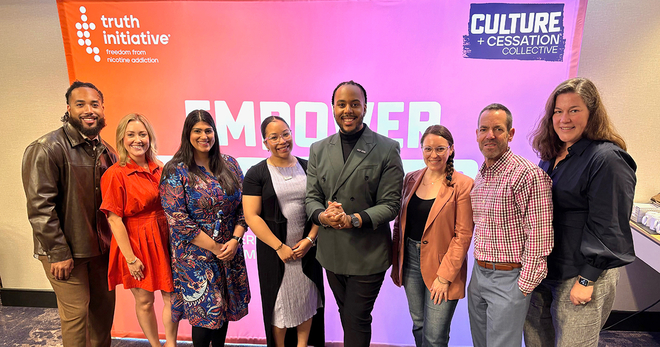Where we stand: Raising the tobacco age to 21
Truth Initiative® strongly supports raising the minimum age of sale for all tobacco products to 21 as part of a strong tobacco control policy program.
21+
Raising the minimum age of sale for cigarettes and all tobacco products to 21 is a critical tool that can help end the tobacco epidemic.
Tobacco remains the number one cause of preventable death and disease in this country, with nearly 500,000 premature deaths a year due to tobacco use. In 2014, the Surgeon General estimated that if tobacco use trends remain on this path, 5.6 million U.S. youth will die prematurely due to smoking. Truth Initiative is committed to creating a world where tobacco is a thing of the past and achieving a culture where youth and young adults reject tobacco. Because most tobacco users start before age 18, and nearly all start before 26, reducing youth access to tobacco is a key tool in accomplishing our mission. For that reason, we support raising the minimum age of sale for all tobacco products to 21.
RATIONALE
Tobacco use among youth has long been a concern because of the harms inherently associated with tobacco use. Evidence suggests that nicotine use during adolescence and young adulthood has long term impacts on brain development, and may make it more difficult to quit using tobacco later. While we have made great strides in reducing both youth and young adult cigarette smoking nationwide, every day more than 3,200 youth smoke their first cigarette and another 2,100 youth and young adult occasional smokers become daily smokers. Young adulthood is also a critical time of development and experimentation. In fact, surveys show that the age of initiation is increasing. So much, in fact, that Truth Initiative shifted the focus of its truth® tobacco prevention campaign from 12-17-year-olds to 15-21-year-olds. Additionally, for nearly one third of young smokers, the transition to daily smoking will not occur until after age 18 and young adults have the highest prevalence of current cigarette smoking of any age group. Further, one study showed that half of people who try cigarettes in college still smoke four years later, despite their predictions that they would quit. Clearly, more needs to be done to end this epidemic.
The Family Smoking Prevention and Tobacco Control Act and the recent “deeming regulation” bringing all tobacco products under the jurisdiction of the Food and Drug Administration sets the minimum age for sale of all tobacco products at 18. At the same time, the Tobacco Control Act prohibits the FDA from further raising the minimum legal age of sale. States and some localities, however, have the authority to set the minimum age of sale for tobacco products and can raise the age beyond the federal requirement. The first community to raise the age to purchase tobacco to 21 was Needham, Massachusetts, in 2005. Studies conducted in that community showed that past 30-day cigarette smoking among youth was cut almost in half, and frequent smoking in youth dropped by 62 percent. These decreases were significantly larger than those experienced in communities in Massachusetts that did not pass this ordinance. Slowly, over the years, more and more towns and villages passed such laws. New York City was the first large city to make this move in 2013. Currently, most states have a minimum age of sale for tobacco products of 18, but three states have an age of 19 (Alabama, Alaska and Utah), and five states (Hawaii, California, New Jersey, Maine and Oregon) set a minimum age of 21. There are approximately 270 localities that have raised the minimum age of tobacco sales to 21.
THE NATIONAL ACADEMY OF MEDICINE CONCLUDED THAT INCREASING THE AGE OF SALE TO 21 IS LIKELY TO DELAY INITIATION AND REDUCE TOBACCO USE.
A 2015 National Academy of Medicine (formerly the Institute of Medicine) report, commissioned by the FDA and required by the Tobacco Control Act, concluded that increasing the age of purchase of tobacco products to 21 could decrease initiation rates among youth and young adults. The impact was greatest among 15-17-year-olds — with an approximate 25 percent decrease in initiation — a substantial decrease — but there was also a strong impact among 18- and 19-20-year-olds — with a nearly 15 percent decrease in initiation rate in both age groups. This reduction or delay in initiation rates, in turn, has an impact on overall smoking prevalence, as well as on the prevalence of other tobacco products. This improves overall health, in both the short and long term, by reducing smoking and other tobacco product-related health effects. Further, it will reduce secondhand smoke exposure. In addition, the National Academy of Medicine found in its modeling that increasing the age of tobacco purchase, and the subsequent reduction in maternal and paternal smoking, will likely improve maternal, fetal and infant health outcomes.
Tobacco is not the first product to be restricted to age 21. The sale of alcohol has been restricted, in most states, to those over 21 since the 1980s. Several studies have shown that the restriction on alcohol sales to those 21 and older has been successful in reducing drunk driving incidents, as well as contributing to significant decreases in alcohol use and binge drinking among highschoolers. In its report, the NAM determined that “the experience with raising the [minimum legal drinking age] for alcohol is highly suggestive with respect to the prospects that raising the [minimum legal age] for tobacco will appreciably reduce smoking rates.”
Indeed, one study estimated that raising the age of purchase of tobacco products to 21 could help reduce youth tobacco use prevalence. Another modeling study determined that increasing the age of purchase to 21 would cause a significant drop in youth smoking in seven years. The study concluded that increasing the age of purchase reduced youth smoking rates more than a 100 percent tax increase.
POLICIES TO INCREASE THE MINIMUM AGE OF SALE TO 21 MUST APPLY TO ALL TOBACCO PRODUCTS.
Truth Initiative supports raising the age to purchase tobacco to 21 for all tobacco products — not just cigarettes. As stated earlier, evidence suggests that nicotine can have long-term effects on the developing adolescent brain; the brain develops until age 25. Further, while cigarette use among adolescents has decreased, all tobacco use has remained flat over the last five years. What’s more, the rate of high school students using more than one tobacco product has increased over the last five years. While some tobacco products, like cigars and smokeless tobacco, have seen some decrease over the last five years, it has not been as steep a decrease as in cigarettes, particularly in the last two years. For some products, such as hookah and electronic nicotine delivery systems (ENDS), we have seen use among high school students remain disturbingly high.
RETAILERS MUST BEAR THE RESPONSIBILITY FOR ENFORCING LAWS INCREASING THE MINIMUM AGE OF SALE TO 21; THE BURDEN SHOULD NOT BE ON THE PURCHASER.
Truth Initiative supports policies that put the burden of enforcement of this policy on retailers, rather than on youth. Youth should not bear the burden of purchase, use or possession laws, which do not take into account the acts of irresponsible retailers and industry marketing. The responsibility for minimum age of sale laws lies squarely on the retailer.
The tobacco industry has disproportionately targeted communities of color. As a result, populations in some communities use tobacco at higher rates than others in the general population. Further, a huge body of research exists showing the impact of tobacco industry marketing on youth and young adult initiation. What is more, studies show that purchase, use or possession laws are ineffective and poorly enforced. Further, these laws have been found to disproportionately impact African-American and Hispanic students.
Unfortunately, most states have purchase, use or possession laws. Increasing the minimum age of sale of tobacco products to 21 could create an opportunity to change those laws. Indeed, Chicago, Illinois, and Cleveland, Ohio, both included language in their laws to eliminate or ensure there were no penalties for purchase, use or possession.
INCREASING THE MINIMUM AGE OF SALE TO 21 IS ONE OF MANY TOOLS TO REDUCE TOBACCO USE AMONG YOUTH AND YOUNG ADULTS.
Truth Initiative strongly supports increasing the minimum age to 21, however, we do not believe this is the only way to reduce youth tobacco initiation and use. There are many evidence-based measures to decrease tobacco use among youth and in the general population. The key policies and programs include:
- Increasing the price of tobacco products
Most communities do this through tobacco taxes. Studies show that every 10 percent increase in tobacco tax reduces youth tobacco use by 7 percent and decreases tobacco consumption by 4 percent. Other options to increase the price of tobacco products include bans on coupon redemption and minimum price floors for tobacco products. - Establishing smoke- and tobacco-free environments
These policies reduce secondhand smoke exposure and contribute to those working in tobacco-free environments smoking fewer cigarettes. - Fully funding tobacco control programs at the state and local level
This helps provide for more quit-smoking services to those who want to quit, as well as programs to help prevent youth and young adults from starting smoking in the first place. - Mass media campaigns to prevent youth from starting smoking as well as encouraging current tobacco users to quit
- Policies to reduce access to tobacco products (e.g., establishing a minimum age of sale, keeping products behind the counter, prohibiting vending machine sales)
- Denormalization strategies, including decreasing youth exposure to tobacco use in movies and other media
The less smoking youth see in the media they consume, the less likely they are to initiate tobacco use.
Increasing the age of sale for tobacco to 21 can help reduce youth tobacco use, especially when combined with these other policies. Truth Initiative encourages communities to adopt all of these policies — including increasing the minimum age of sale to 21.
CONCLUSION
Truth Initiative finds the NAM report, and the experiences of those communities and states that have already established a minimum age of sale of 21 for tobacco products, compelling. Truth Initiative is dedicated to finishing tobacco and supports policies that contribute to that goal. Raising the age of sale for tobacco to 21 has the potential to help end tobacco use once and for all.
More in tobacco prevention efforts
Want support quitting? Join EX Program
By clicking JOIN, you agree to the Terms, Text Message Terms and Privacy Policy.
Msg&Data rates may apply; msgs are automated.


